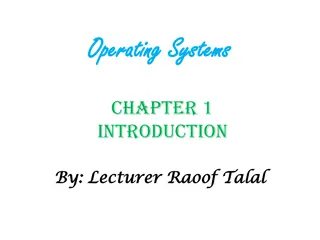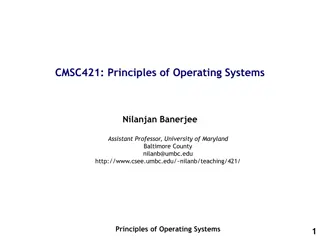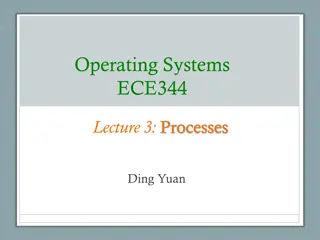Understanding Operating System Concepts: Lecture Overview and Services
Exploring the lecture content on operating system concepts, structures, services, system calls, and file manipulation. Delve into the importance of operating system services, error detection, program execution, I/O operations, protection, security, and resource allocation in operating systems. Learn about system calls and their role in providing interfaces to system services.
Download Presentation

Please find below an Image/Link to download the presentation.
The content on the website is provided AS IS for your information and personal use only. It may not be sold, licensed, or shared on other websites without obtaining consent from the author. Download presentation by click this link. If you encounter any issues during the download, it is possible that the publisher has removed the file from their server.
E N D
Presentation Transcript
Lecture 2 Lecture 2 COperating System Structures References for Lecture: Abraham Silberschatz, Peter Bear Galvin and Greg Gagne, Operating System Concepts, 9th Edition, Chapter 2 2
Contents of Lecture Operating System Services System Calls Types of System Calls Operating System Structure
Operating System Services Operating systems provide an environment for execution of programs and services to programs and users. One set of operating-system services provides functions that are helpful to the user
File-system manipulation: The file system is of particular interest. Programs need Communications: Processes may exchange information, on the same computer or Error detection: OS needs to be aware of possible errors. For each type of error, OS should take the appropriate action to ensure correct and User interface: Almost all operating systems have a user interface (UI). Varies between Command-Line (CLI), Graphics User Interface (GUI), Batch. to run that program, end execution, either normally or abnormally (indicating error). an I/O device. Error may occur in the CPU and memory hardware, in I/O devices, in user program Program execution: The system must be able to load a program into memory and I/O operations: A running program may require I/O, which may involve a file or to read and write files and directories, create and delete them, search them, list file between computers over a network. May be via shared memory or through message consistent computing. Debugging facilities can greatly enhance the user s and Operating System Services Information, permission management passing (packets moved by the OS). programmer s abilities to efficiently use the system.
Protection and security: The owners of information stored in a multiuser or Protection, involves ensuring that all access to system resources is controlled Resource allocation: When multiple users or multiple jobs running concurrently, resources must be allocated to each of them. Accounting: To keep track of which users use how much and what kinds of networked computer system may want to control use of that information, concurrent Security, of the system from outsiders requires user authentication, extends to Another set of OS functions exists for ensuring the efficient operation of the system itself via resource sharing Many types of resources - CPU cycles, main memory, file storage, I/O devices. computer resources processes should not interfere with each other defending external I/O devices from invalid access attempts.
System Calls System calls provide an interface to the services made available by an operating system. These calls are generally available as routines written in C and C++, although certain low-level tasks (for example, tasks where hardware must be accessed directly) may have to be written using assembly-language instructions.
System Calls Example of System Calls An example to illustrate how system calls are used: writing a simple program to read data from one file and copy them to another file.
System Calls As you can see, even simple programs may make heavy use of the operating system. Systems execute thousands of system calls per second. Most programmers never see this level of detail, however. Typically, application developers design programs according to an application programming interface (API). The API specifies a set of functions that are available to an application programmer, including the parameters that are passed to each function and the return values the programmer can expect.
System Calls Example of Standard API:
System Calls Three of the most common APIs available to application programmers are: 1) Windows (Win32) API for Windows systems. 2) The POSIX API for POSIX-based systems (which include virtually all versions of UNIX, Linux, and Mac OS X). 3) The Java API for programs that run on the Java virtual machine (JVM). A programmer accesses an API via a library of code provided by the operating system. In the case of UNIX and Linux for programs written in the C language, the library is called libc.
System Calls System Call Implementation For most programming languages, the run-time support system (a set of functions built into libraries included with a compiler) provides a system call interface that serves as the link to system calls made available by the operating system. The system-call interface intercepts function calls in the API and invokes the necessary system calls within the operating system. Typically, a number is associated with each system call, and the system-call interface maintains a table indexed according to these numbers.
System Calls System Call Implementation The system call interface then invokes the intended system call in the operating-system kernel and returns the status of the system call and any return values. The caller need know nothing about how the system call is implemented Just needs to obey API and understand what OS will do as a result call Most details of OS interface hidden from programmer by API Managed by run-time support library (set of functions built into libraries included with compiler)
System Calls System Call Implementation The relationship between an API, the system-call interface, and the operating system is shown in next figure (Figure 2.6), which illustrates how the operating system handles a user application invoking the open() system call.
System Calls System Call Parameter Passing Often, more information is required than simply identity of desired system call Exact type and amount of information vary according to OS and call not limit the number or length of parameters being passed Note Some operating systems prefer the block and stack methods do Three general methods used to pass parameters to the OS 1. Simplest: pass the parameters in registers In some cases, may be more parameters than registers 2. Parameters stored in a block, or table, in memory, and address of block passed as a parameter in a register. This approach taken by Linux and Solaris 3. Parameters placed, or pushed, onto the stack by the program and popped off the stack by the operating system.
Types of System Calls Process control create process, terminate process end, abort load, execute get process attributes, set process attributes wait for time wait event, signal event allocate and free memory Dump memory if error Debugger for determining bugs, single step execution Locks for managing access to shared data between processes
Types of System Calls File management create file, delete file open, close file read, write, reposition get and set file attributes Device management request device, release device read, write, reposition get device attributes, set device attributes logically attach or detach devices
Types of System Calls Information maintenance get time or date, set time or date get system data, set system data get and set process, file, or device attributes Communications create, delete communication connection send, receive messages if message passing model to host name or process name From client to server Shared-memory model create and gain access to memory regions transfer status information attach and detach remote devices
Types of System Calls Protection Control access to resources Get and set permissions Allow and deny user access
Types of System Calls Examples of Windows and Unix System Calls
Types of System Calls Standard C Library Example The standard C library provides a portion of the system-call interface for many versions of UNIX and Linux. As an example, C program invokes the printf() statement. The C library intercepts this call and invokes the necessary system call (or calls) in the operating system in this instance, the write() system call. The C library takes the value returned by write() and passes it back to the user program.
Operating System Structure General-purpose OS is very large program Various ways to structure ones: 1) Simple structure MS-DOS 2) More complex -- UNIX 3) Layered an abstrcation 4) Microkernel Mach
Operating System Structure 1) Simple structure MS-DOS MS-DOS written to provide the most functionality in the least space Not divided into modules. Although MS-DOS has some structure, interfaces and levels of functionality are not well separated its
Operating System Structure 2) More complex -- UNIX UNIX limited by hardware functionality, the original UNIX operating system had limited structuring. The UNIX OS consists of two separable parts: Systems programs The kernel Consists of everything below the system-call interface and above the physical hardware Provides the file system, CPU scheduling, memory management, and other operating-system functions; a large number of functions for one level Traditional UNIX System Structure beyond simple but not fully layered
Operating System Structure 3) Layered an abstrcation The divided into a number of layers (levels), each built on top of lower layers. The bottom layer (layer 0), is the hardware; the highest (layer N) is the user interface. operating system is With modularity, layers are selected such that each uses functions (operations) services of only lower-level layers and
Operating System Structure 4) Microkernel Mach Moves as much from the kernel into user space Mach example of microkernel Mac OS X kernel (Darwin) partly based on Mach Communication takes place between user modules using message passing messages Application Program File Device Driver user mode System messages Benefits: Easier to extend a microkernel Easier to port the operating system to new architectures More reliable (less code is running in kernel mode) More secure memory managment CPU Interprocess Communication kernel mode scheduling microkernel Detriments: Performance overhead of user space to kernel space communication hardware























